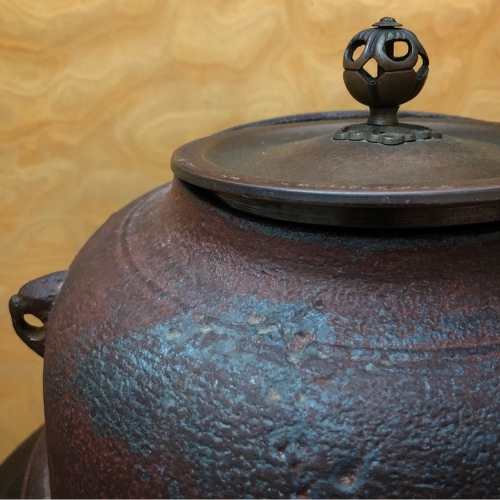 Nothing seems to sum up the spirit of tea more than the movement of the brazier. In Summer, the 風炉 furo (portable “wind brazier”) is brought out and placed far from the guest, with the 水差 mizusashi (cool water container) placed between them. Yet, as Autumn continues and the weather cools, the host brings the brazier closer, setting it in the center of the 道具畳 dōgu-datami (lit. “mat upon which the teaware is placed”), and moving the mizusashi away from the guest. The effect of this arrangement, called 中置 nakaoki (lit. “center placement“), creates both a visual and physical inference of warmth, as the gentle heat radiating from the furo can now be felt by the guest. This subtle rearranging of the brazier, which only lasts for the final weeks of Autumn, perfectly articulates the ethos of 茶の湯 chanoyu (Japanese tea ceremony): a tenderness to the seasons and to the guest, regarding all aspects (visual, physical, spatial, temporal, emotional, and spiritual).
Nothing seems to sum up the spirit of tea more than the movement of the brazier. In Summer, the 風炉 furo (portable “wind brazier”) is brought out and placed far from the guest, with the 水差 mizusashi (cool water container) placed between them. Yet, as Autumn continues and the weather cools, the host brings the brazier closer, setting it in the center of the 道具畳 dōgu-datami (lit. “mat upon which the teaware is placed”), and moving the mizusashi away from the guest. The effect of this arrangement, called 中置 nakaoki (lit. “center placement“), creates both a visual and physical inference of warmth, as the gentle heat radiating from the furo can now be felt by the guest. This subtle rearranging of the brazier, which only lasts for the final weeks of Autumn, perfectly articulates the ethos of 茶の湯 chanoyu (Japanese tea ceremony): a tenderness to the seasons and to the guest, regarding all aspects (visual, physical, spatial, temporal, emotional, and spiritual).
As Autumn takes hold of New York City, the air begins to chill and fresh breezes pull leaves from the trees, scattering them and blanketing the streets with a tapestry of gold, ocher and crimson. Even on the most busy of days, the settling of tumbling leaves brings a sense of calm to the mind, offering a moment to meditate on all that will pass in this season, this year, and this lifetime.
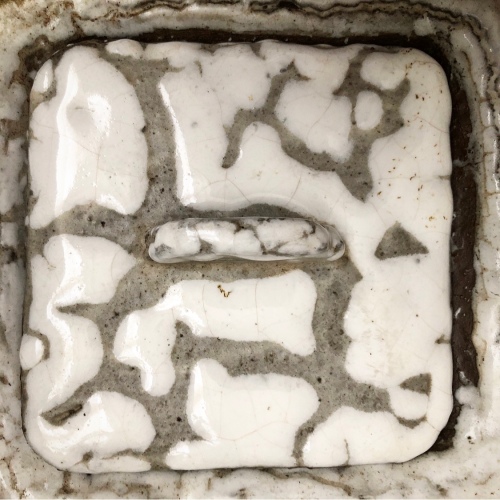 In the tearoom, this motion and stillness is felt as I position my antique furo and 茶釜 chagama (spoutless kettle) to the center of the host position. To my left, I place a tall, slender 鬼萩 Oni Hagi (lit. “Demon Hagi”) mizusashi.
In the tearoom, this motion and stillness is felt as I position my antique furo and 茶釜 chagama (spoutless kettle) to the center of the host position. To my left, I place a tall, slender 鬼萩 Oni Hagi (lit. “Demon Hagi”) mizusashi.
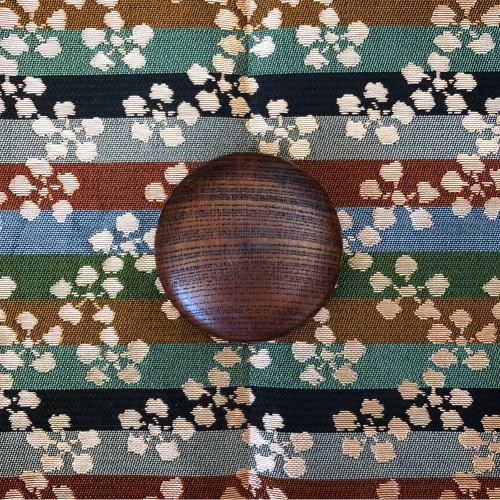 As my guest arrives, the soft scent of incense lingers in the air. As they enter the tearoom, the sound of the kettle creates a calming sense of emptiness. In the alcove, a small orange chrysanthemum is paired with an unadorned wooden incense container. As host, I leave my guest to sit and take in the many aspects of the space, turning a moment’s pause into a quiet meditation.
As my guest arrives, the soft scent of incense lingers in the air. As they enter the tearoom, the sound of the kettle creates a calming sense of emptiness. In the alcove, a small orange chrysanthemum is paired with an unadorned wooden incense container. As host, I leave my guest to sit and take in the many aspects of the space, turning a moment’s pause into a quiet meditation.
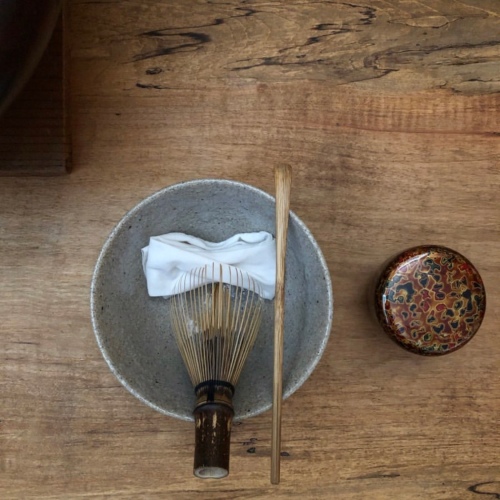 Pushing open the door, I greet my guest and approach them, offering a tea sweet before I bring out the assembled teaware to prepare a bowl of 抹茶 matcha (“powdered tea”). Set before the now vacant side of the furo, I place a small grey 井戸茶碗 Ido chawan (“Ido teabowl”) and a small, iridescent 若狭塗棗 Wakasa-nuri natsume (“Wakasa lacquer tea caddy”), its spangled surface of red, gold, green and black perfectly mirroring the changing leaves of late Autumn.
Pushing open the door, I greet my guest and approach them, offering a tea sweet before I bring out the assembled teaware to prepare a bowl of 抹茶 matcha (“powdered tea”). Set before the now vacant side of the furo, I place a small grey 井戸茶碗 Ido chawan (“Ido teabowl”) and a small, iridescent 若狭塗棗 Wakasa-nuri natsume (“Wakasa lacquer tea caddy”), its spangled surface of red, gold, green and black perfectly mirroring the changing leaves of late Autumn.
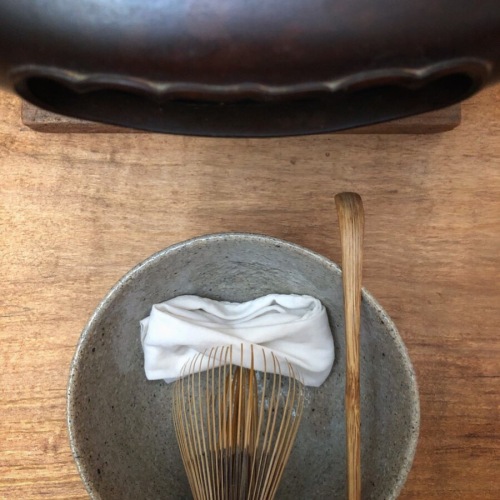 Accompanied to the sound of bubbling water, I set about cleansing each item, placing them into position to make a bowl of tea. The teabowl is moved before the rough wooden 敷板 shiki-ita (the board that goes under the furo), itself a section of old floorboard from a since-destroyed Victorian farmhouse.
Accompanied to the sound of bubbling water, I set about cleansing each item, placing them into position to make a bowl of tea. The teabowl is moved before the rough wooden 敷板 shiki-ita (the board that goes under the furo), itself a section of old floorboard from a since-destroyed Victorian farmhouse.
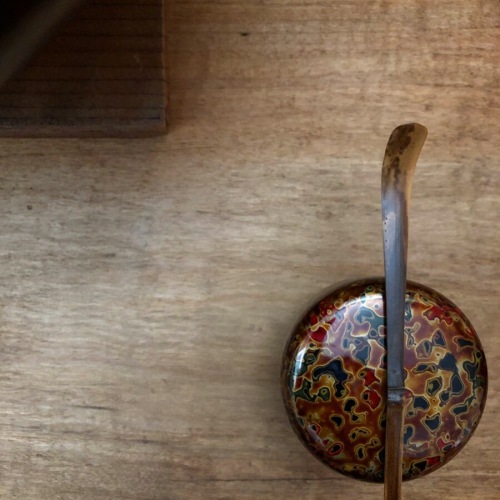 The lacquer natsume and bamboo 茶杓 chashaku (tea scoop), once purified by my purple silk 袱紗 fukusa (a silk cloth for cleansing teaware), are set a measured distance beside this.
The lacquer natsume and bamboo 茶杓 chashaku (tea scoop), once purified by my purple silk 袱紗 fukusa (a silk cloth for cleansing teaware), are set a measured distance beside this.
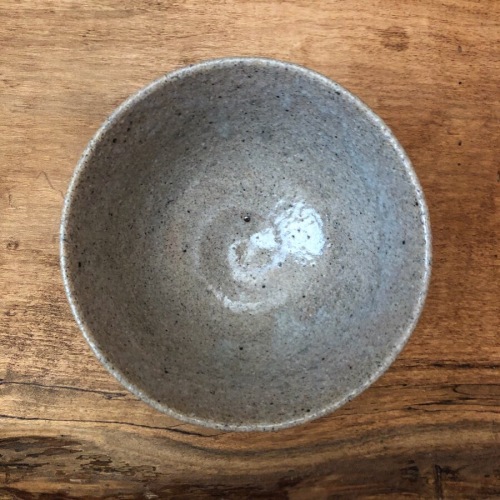 Once cleansed and warmed by the water from the chagama, the Ido chawan shines with muted tones of sky blue, soft slate and the grey of a cold Autumnal day.
Once cleansed and warmed by the water from the chagama, the Ido chawan shines with muted tones of sky blue, soft slate and the grey of a cold Autumnal day.
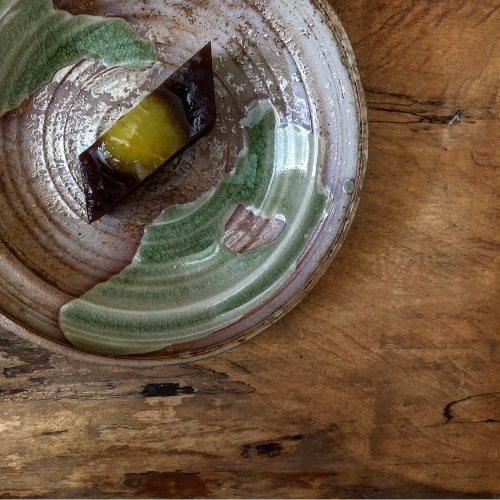 I motion to my guest that they may enjoy their tea sweet, a seasonal 栗羊羹 kuri yōkan (sweet bean jelly with chestnut).
I motion to my guest that they may enjoy their tea sweet, a seasonal 栗羊羹 kuri yōkan (sweet bean jelly with chestnut).
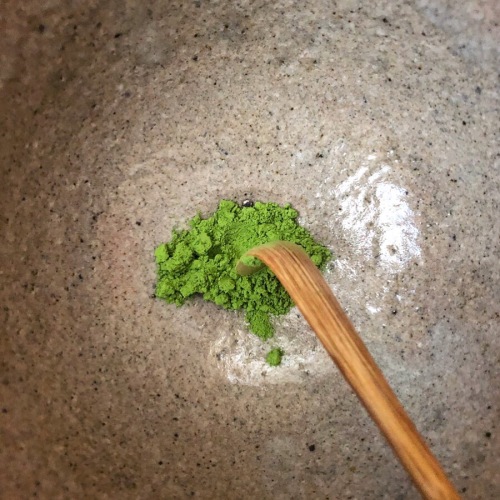 Three scoops of bright green matcha powder are issued out into the center of the bowl, placed one on top of the other, into the recess of the swirl-shaped 茶溜まり chadamari (lit. “tea pool”).
Three scoops of bright green matcha powder are issued out into the center of the bowl, placed one on top of the other, into the recess of the swirl-shaped 茶溜まり chadamari (lit. “tea pool”).
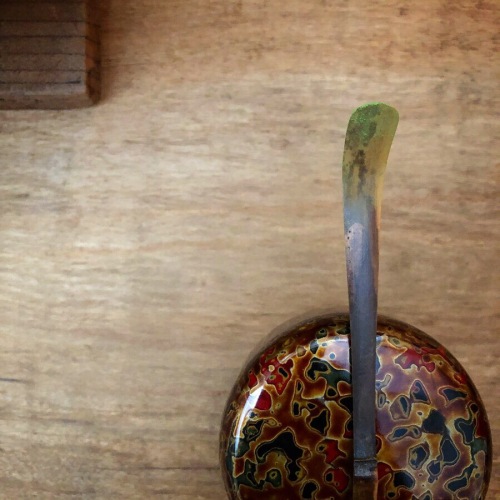 Placing the chashaku back atop the lid of the natsume, I pour a half-ladle’s worth of hot water into the teabowl and begin to whisk the tea.
Placing the chashaku back atop the lid of the natsume, I pour a half-ladle’s worth of hot water into the teabowl and begin to whisk the tea.
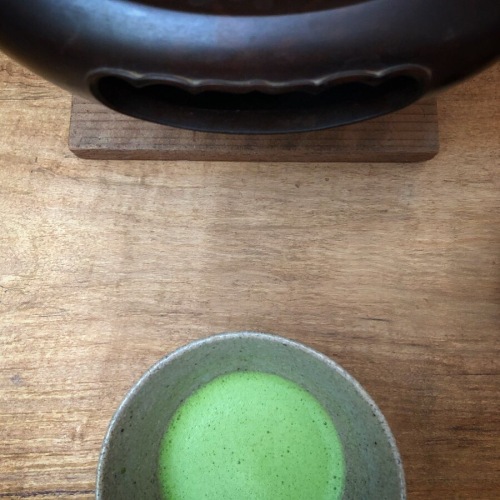 The bright foam produced appears soft and slightly domed. The circumference of the teabowl and apex of this dome appear perfectly in line with the center axis of the furo and dōgu-datami. This line, in turn, continues on through the center of my body. At this moment, time, space, objects, and intention are all aligned.
The bright foam produced appears soft and slightly domed. The circumference of the teabowl and apex of this dome appear perfectly in line with the center axis of the furo and dōgu-datami. This line, in turn, continues on through the center of my body. At this moment, time, space, objects, and intention are all aligned.
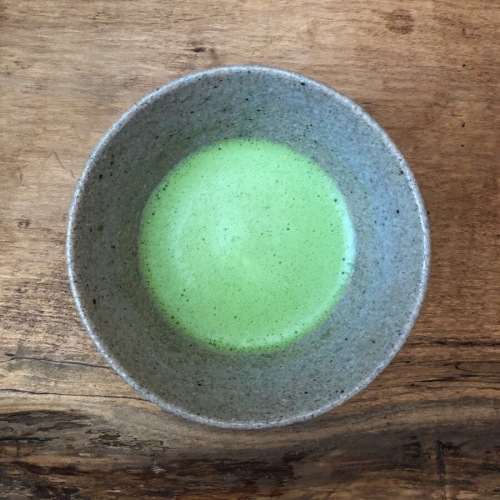 Lifting the bowl, I turn to offer it to my guest. We both pause and bow, and for a moment, only the boiling kettle can be heard.
Lifting the bowl, I turn to offer it to my guest. We both pause and bow, and for a moment, only the boiling kettle can be heard.
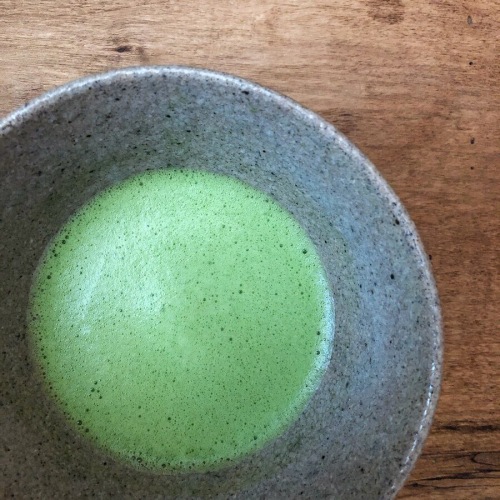 As I turn once again towards the furo, my guest lifts the bowl and drinks the tea. Once fully enjoyed, they take a moment to hold the bowl, inspecting both its interior and the unctuous glaze on its exterior.
As I turn once again towards the furo, my guest lifts the bowl and drinks the tea. Once fully enjoyed, they take a moment to hold the bowl, inspecting both its interior and the unctuous glaze on its exterior.
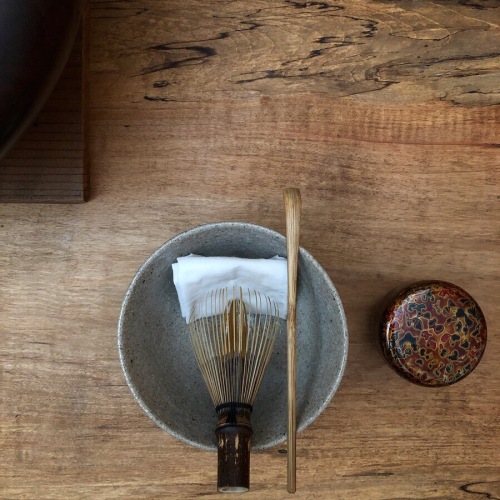 Afterwards, the bowl is returned and I set about cleaning it one last time.
Afterwards, the bowl is returned and I set about cleaning it one last time.
As we both sit in the still world of the tearoom, both host and guest enjoy the pleasant warmth of the brazier. Moved closer to the guest in accordance with Autumn’s growing chill, this marks yet another change seen during the year. In a few weeks, this too shall change. Autumn’s leaves will have been blown from the trees, leaving them bare as Winter settles in. The furo, too, will be put away, replaced by the sunken hearth of the cold season.

very nice article. Today in tea lesson we reviewed nakaoki temae. perfect timing!
If you can, share pictures and any of your experiences! No pressure or expectations, but learning new motions is always interesting!